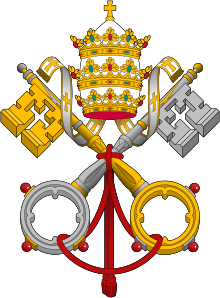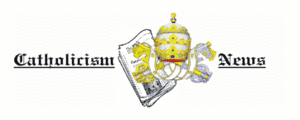
Back بوابة:الكنيسة الرومانية الكاثوليكية Arabic Уикипедия:Светци Bulgarian Portalo:Katolika Eklezio Esperanto Portal:Iglesia católica Spanish Portail:Catholicisme French Portál:Katolicizmus Hungarian Portale:Cattolicesimo Italian Portal:Katolik Malay Portal:Den katolske kirke NB Portal:Katolicyzm Polish
Introduction The Catholic Church, also known as the Roman Catholic Church, is the largest Christian church, with 1.28 to 1.39 billion baptized Catholics worldwide as of 2024. It is among the world's oldest and largest international institutions and has played a prominent role in the history and development of Western civilization. The church consists of 24 sui iuris churches, including the Latin Church and 23 Eastern Catholic Churches, which comprise almost 3,500 dioceses and eparchies around the world. The pope, who is the bishop of Rome, is the chief pastor of the church. The Diocese of Rome, known as the Holy See, is the central governing authority of the church. The administrative body of the Holy See, the Roman Curia, has its principal offices in Vatican City, which is a small, independent city-state and enclave within the city of Rome, of which the pope is head of state. The core beliefs of Catholicism are found in the Nicene Creed. The Catholic Church teaches that it is the one, holy, catholic and apostolic church founded by Jesus Christ in his Great Commission, that its bishops are the successors of Christ's apostles, and that the pope is the successor to Saint Peter, upon whom primacy was conferred by Jesus Christ. It maintains that it practises the original Christian faith taught by the apostles, preserving the faith infallibly through scripture and sacred tradition as authentically interpreted through the magisterium of the church. The Roman Rite and others of the Latin Church, the Eastern Catholic liturgies, and institutes such as mendicant orders, enclosed monastic orders and third orders reflect a variety of theological and spiritual emphases in the church. Of its seven sacraments, the Eucharist is the principal one, celebrated liturgically in the Mass. The church teaches that through consecration by a priest, the sacrificial bread and wine become the body and blood of Christ. The Virgin Mary is venerated as the Perpetual Virgin, Mother of God, and Queen of Heaven; she is honoured in dogmas and devotions. Catholic social teaching emphasizes voluntary support for the sick, the poor, and the afflicted through the corporal and spiritual works of mercy. The Catholic Church operates tens of thousands of Catholic schools, universities and colleges, hospitals, and orphanages around the world, and is the largest non-government provider of education and health care in the world. Among its other social services are numerous charitable and humanitarian organizations. (Full article...) Selected article
 The papal election from November 1268 to September 1, 1271, following the death of Pope Clement IV, was the longest papal election in the history of the Roman Catholic Church. The election of Tebaldo Visconti as Pope Gregory X, the first example of a papal election by "Compromise," was effected by a Committee of six cardinals agreed to by the other remaining ten, occurred more than a year after the magistrates of Viterbo locked the cardinals in, reduced their rations to bread and water, and legendarily removed the roof of the Palazzo dei Papi di Viterbo.As a result of the length of the election, during which three of the twenty cardinal-electors died and one resigned, Gregory X promulgated the apostolic constitution, Ubi periculum, on July 7, 1274 (or 16), during the Second Council of Lyon, establishing the papal conclave, whose rules were based on the tactics employed against the cardinals in Viterbo. The election itself is sometimes viewed as the first conclave.
Selected image
 Credit: Diliff St. Vitus Cathedral (Czech: Katedrála svatého Víta) is a Roman Catholic cathedral in Prague, Czech Republic, and the seat of the Archbishop of Prague. The full name of the cathedral is St. Vitus, St. Wenceslas and St. Adalbert Cathedral. Located within Prague Castle and containing the tombs of many Bohemian kings, this cathedral is an excellent example of Gothic architecture and is the biggest and most important church in the country. Selected biography
Joseph Havens Richards SJ (born Havens Cowles Richards; November 8, 1851 – June 9, 1923) was an American Catholic priest and Jesuit who became a prominent president of Georgetown University, where he instituted major reforms and significantly enhanced the quality and stature of the university. Richards was born to a prominent Ohio family; his father was an Episcopal priest who controversially converted to Catholicism and had the infant Richards secretly baptized as a Catholic. Richards became the president of Georgetown University in 1888 and undertook significant construction, such as the completion of Healy Hall, which included work on Gaston Hall and Riggs Library, and the building of Dahlgren Chapel. Richards sought to transform Georgetown into a modern, comprehensive university. To that end, he bolstered the graduate programs, expanded the School of Medicine and Law School, established the Georgetown University Hospital, improved the astronomical observatory, and recruited prominent faculty. He also navigated tensions with the newly established Catholic University of America, which was located in the same city. Richards fought anti-Catholic discrimination by Ivy League universities, resulting in Harvard Law School admitting graduates of some Jesuit universities. Upon the end of his term in 1898, Richards engaged in pastoral work attached to Jesuit educational institutions throughout the northeastern United States. He became the president of Regis High School and the Loyola School in New York City in 1915, and he was then made superior of the Jesuit retreat center on Manresa Island in Connecticut. Richards died at the College of the Holy Cross in 1923. (Full article...) Did you know...
Related portalsFeast Day of November 28
Selected quote

News
SubcategoriesTopics
The Holy Bible:
Particular Churches (grouped by liturgical rite):
Things you can do
External resourcesWikiProjectsAssociated WikimediaThe following Wikimedia Foundation sister projects provide more on this subject:
Discover Wikipedia using portals |


































